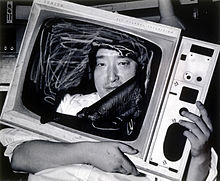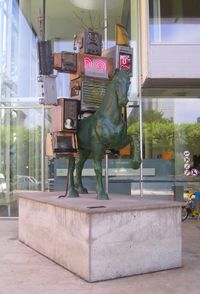- Nam June Paik
-
Nam June Paik 
The picture was taken by Lim Young-kyun in 1983 while Nam June Paik was in New York CityKorean name Hangul 백남준 Hanja 白南準 Revised Romanization Baek Namjun McCune–Reischauer Paek Namjun Nam June Paik (July 20, 1932 – January 29, 2006) was a Korean-born American artist. He worked with a variety of media and is considered to be the first video artist.[1]
Paik is credited with an early usage (1974) of the term "super highway" in application to telecommunications.
Contents
Early life
Born in Seoul during the colonial period of Korea, the youngest of five siblings, Paik had 2 older brothers and 2 older sisters. His father owned a major textile manufacturing firm. As he was growing up, he was trained as a classical pianist. In 1950, Paik and his family had to flee from their home in Korea, during the Korean War. His family first fled to Hong Kong, but later moved to Japan. Six years later he graduated from the University of Tokyo where he wrote a thesis on the composer Arnold Schoenberg.
Paik then moved to Germany to study music history at Munich University. While studying in Germany, Paik met the composers Karlheinz Stockhausen and John Cage and the conceptual artists Joseph Beuys and Wolf Vostell who inspired him to work in the field of electronic art.[2]
Works
 Pre-Bell-Man, statue in front of the 'Museum für Kommunikation', Frankfurt am Main, Germany
Pre-Bell-Man, statue in front of the 'Museum für Kommunikation', Frankfurt am Main, Germany
Nam June Paik then began participating in the Neo-Dada art movement, known as Fluxus, which was inspired by the composer John Cage and his use of everyday sounds and noises in his music. He made his big debut at an exhibition known as Exposition of Music-Electronic Television, in which he scattered televisions everywhere and used magnets to alter or distort their images.
In 1964, Paik moved to New York, and began working with classical cellist Charlotte Moorman, to combine his video, music, and performance. In the work TV Cello, the pair stacked televisions on top one another, so that they formed the shape of an actual cello. When Moorman drew her bow across the "cello," images of her and other cellists playing appeared on the screens.
In 1965, Sony introduced the Portapak (though it is said that Paik had a similar one before Sony released theirs). With this, Paik could both move and record things, for it was the first portable video and audio recorder. From there, Paik became an international celebrity, known for his creative and entertaining works.[3]
In a notorious 1967 incident, Moorman was arrested for going topless while performing in Paik’s Opera Sextronique. Two years later, in 1969, they performed TV Bra for Living Sculpture, in which Moorman wore a bra with small TV screens over her breasts.[4] Throughout this period it was his goal to bring music up to speed with art and literature, and make sex an acceptable theme. One of his Fluxus pieces instructs the performer to climb up inside the vagina of a living sperm whale.[5]
In 1971, he made a cello out of three television sets stacked up on top of each other and some cello strings. He got a famous cellist to play the "cello" as well.[6]
In 1974 Nam June Paik used the term "super highway" in application to telecommunications, which gave rise to the opinion that he may have been the author of the phrase "Information Superhighway".[7] In fact, in his 1974 proposal "Media Planning for the Postindustrial Society – The 21st Century is now only 26 years away" to Rockefeller Foundation he used a slightly different phrase, "electronic super highway":[8]
"The building of new electronic super highways will become an even huger enterprise. Assuming we connect New York with Los Angeles by means of an electronic telecommunication network that operates in strong transmission ranges, as well as with continental satellites, wave guides, bundled coaxial cable, and later also via laser beam fiber optics: the expenditure would be about the same as for a Moon landing, except that the benefits in term of by-products would be greater."
Many of Paik's early works and writings are collected in a volume edited by Judson Rosebush titled Nam June Paik: Videa 'n' Videology 1959–1973, published by the Everson Museum of Art, Syracuse, New York, in 1974.
In another work, Something Pacific (1986), a statue of a sitting Buddha faces its image on a closed circuit television. (The piece is part of the Stuart Collection of public art at the University of California, San Diego.) Another piece, Positive Egg, displays a white egg on a black background. In a series of video monitors, increasing in size, the image on the screen becomes larger and larger, until the egg itself becomes an abstract, unrecognizable shape. In Video Fish,[9] from 1975, a series of aquariums arranged in a horizontal line contain live fish swimming in front of an equal number of monitors which show video images of other fish.
Paik’s 1995 piece Electronic Superhighway: Continental U.S., Alaska, Hawaii, on permanent display at the Lincoln Gallery of the Smithsonian American Art Museum, is a stunning example of his cultural criticism. With this piece, Paik offers up his commentary about an American culture obsessed with television, the moving image, and bright shiny things.
Paik was known for making robots out of television sets. These were constructed using pieces of wire and metal, but later Paik used parts from radio and television sets. A retrospective of Paik's work was held at the Whitney Museum of American Art in the spring of 1982. During the New Year's Day celebration on January 1, 1984, he aired Good Morning, Mr. Orwell, a live link between WNET New York, Centre Pompidou Paris, and South Korea. With the participation of John Cage, Salvador Dalí, Laurie Anderson, Joseph Beuys, Merce Cunningham, Allen Ginsberg and Peter Orlovsky, George Plimpton, and other artists, Paik showed that George Orwell's Big Brother hadn't arrived. In 1986, Paik created the work Bye Bye Kipling, a tape that mixed live events from Seoul, South Korea; Tokyo, Japan; and New York, USA. Two years later, in 1988 he further showed his love for his home with a piece called The more the better, a giant tower made entirely of 1003 monitors for the Olympic Games being held at Seoul.
From 1979 to 1996 Paik was professor at the Kunstakademie Düsseldorf.
A final retrospective of his work was held in 2000 at the Guggenheim Museum in New York, integrating the unique space of the museum into the exhibition itself.[10] This coincided with a downtown gallery showing of video artworks by his wife Shigeko Kubota, mainly dealing with his recovery from a stroke he had in 1996.
Personal life
In 1996, Paik had a stroke, which paralyzed his left side; he used a wheelchair the last decade of his life. Paik died January 29, 2006, in Miami, Florida, due to complications from his stroke.[11][dead link][12]
Honours and awards
- (2001) Lifetime Achievement in Contemporary Sculpture Award, International Sculpture Center.[13]
Artwork in public collections
Ommah (2005) in the collection of the National Gallery of Art
Public collections that hold work by Nam June Paik include: the National Museum of Contemporary Art (Seoul, Korea), the Ackland Art Museum (University of North Carolina), the Albright-Knox Art Gallery (Buffalo, New York), the Art Museum of the Americas (Washington D.C.), Daimler-Chrysler Collection (Berlin), Fukuoka Art Museum (Fukuoka, Japan), the Hirshhorn Museum and Sculpture Garden (Washington D.C.), the Honolulu Academy of Arts, Kunsthalle zu Kiel (Germany), Kunstmuseum St.Gallen (Switzerland), Kunstsammlung Nordrhein-Westfalen (Düsseldorf, Germany), Ludwig Forum für Internationale Kunst (Aachen, Germany), Musée d'Art Moderne de la Ville de Paris, Museum Wiesbaden (Germany), the National Gallery of Australia (Canberra), the National Museum of Contemporary Art (Athens, Greece), Palazzo Cavour (Turin, Italy), the Royal Museums of Fine Arts of Belgium, Schleswig-Holstein Museums (Germany), the Smart Museum of Art (University of Chicago), Smith College Museum of Art (Massachusetts), the Smithsonian American Art Museum (Washington D.C.), the Stuart Collection (University of California, San Diego), and the Walker Art Center (Minneapolis, Minnesota).
Quotes
- "Our life is half natural and half technological. Half-and-half is good. You cannot deny that high-tech is progress. We need it for jobs. Yet if you make only high-tech, you make war. So we must have a strong human element to keep modesty and natural life."
- "Skin has become inadequate in interfacing with reality. Technology has become the body's new membrane of existence."
- "The future is now."
- "The only way to win a race is to run alone."
- "There is no rewind button for life."
- "When too perfect, lieber Gott böse."
Honors
- Ho-Am Prize in the Arts, 1995
- Order of Cultural Merit, 2007.[14]
References
- ^ Noah Wardrip-Fruin and Nick Montfort, The New Media Reader, MIT Press, 2003, p227. ISBN 0262232278
- ^ Christiane Paul, Digital Art, Thames & Hudson, London, pp. 14–15
- ^ Christiane Paul, Digital Art, Thames & Hudson, London, p. 21
- ^ Media Art Net | Paik, Nam June; Moorman, Charlotte: TV-Bra for Living Sculpture
- ^ Nyman, Michael (1999). Experimental Music. Cambridge University Press. ISBN 978-0-521-65383-1.
- ^ Cox, Michael (1997). Awful Art. Scholastic Children's Books. ISBN 0-590-19262-0.
- ^ [1]
- ^ Nam June Paik, «Media Planning for the Postindustrial Society – The 21st Century is now only 26 years away»
- ^ Nam June Paik
- ^ The Worlds of Nam June Paik
- ^ "Leader of Avant-Garde Electronic Art Movement Dies at 75". VOA News (Voice of America). 2006-02-01. http://voanews.com/english/archive/2006-02/2006-02-01-voa91.cfm. Retrieved 2008-12-25.
- ^ Biography for Nam June Paik, Internet Movie Database. Retrieved 2011.1.24
- ^ International Sculpture Center. Lifetime Achievement in Contemporary Sculpture Award. Retrieved 13 February 2010.
- ^ "Nation honors late video artist Paik Nam-june a year after death," Ministry of Culture, Sports and Tourism (ROK). February 1, 2007, retrieved 2011-04-22
External links
- Official Website of Nam June Paik
- New Ontology of Music essay by Nam June Paik; from Monthly Review of the University for Avant-garde Hinduism
- 9/23 Paik-Abe videosynthesizer performance from WGBH New Television Workshop archives, features short clip
- Electronic Arts Intermix includes a biography and description of major works
- Nam June Paik biography @ MedienKunstNetz
- " If You Miss Paik Nam-June", The Korea Times, February 5, 2006.
- "Paik Nam-june to Be Buried in Homeland", The Korea Times, January 31, 2006.
- "Father of Video Art Paik Nam-june Dies", The Chosun Ilbo, January 30, 2006.
- "Video artist Nam June Paik dead at 74", CNN, January 30, 2006.
- Nam June Paik in the Video Data Bank
- Nam June Paik on Ubu Film
- Nam June Paik in the Mediateca Media Art Space
- Nam June Paik on imdb
- Google celebrated Nam June Paik's Birthday with special logotype
- Tate: TateShots: Nam June Paik. 2011.
- Nam June Paik: "Study I: Mayor Lindsay" (1965)
Listening
- UbuWeb: Nam June Paik featuring Abschiedssymphonie and In Memoriam George Maciunas MP3s offline
- TV Cello, Nam June Paik & Charlotte Moorman performance (MP3: part 1, part 2)
- Concert for TV Cello and Videotapes, Nam June Paik with Charlotte Moorman and Paul Garrin, Museum of Contemporary Art, Chicago, 1982 (MP3: part 1, part 2, part 3)
- MP3 Variations on a Theme by Saint-Saens Charlotte Moorman live at Mills College 03/08/1974
Categories:- 1932 births
- 2006 deaths
- People from Seoul
- American artists
- Contemporary artists
- Fluxus
- Kyunggi High School alumni
- American people of Korean descent
- Korean artists
- Media theorists
- University of Tokyo alumni
- Video artists
- South Korean artists
- Kunstakademie Düsseldorf faculty
Wikimedia Foundation. 2010.


